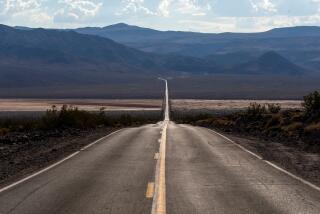TV REVIEW : Grit, Passion Power Drama of ‘Long Road’
- Share via
The Depression-era family saga “Long Road Home” (at 9 tonight on Channels 2 and 8) is as real as a gob of mud and Burma-Shave signs on the highway. The production dares to expand on “The Grapes of Wrath” and gets away with it. Dramatizing the Dust Bowl’s homeless migrants with grit and passion, the show is as expressly American in its sentiments as today’s ubiquitous yellow bow and ribbon.
Three weeks ago, the public wrapped its arms around another slice of historic Americana, CBS’ “Sarah, Plain and Tall.” But the social breadth of “Long Road Home” has the density of a crowded novel. Here’s a network drama that feels like a theatrical movie.
The production’s accomplishments include its smudgy texture, its surprisingly strong performance by Mark Harmon as a dispossessed farmer in the best role and performance of his career, and a strong narrative momentum propelled by Jane-Howard Hammerstein’s teleplay (adapted from the 1989 novel “Long Road Home” by Ronald B. Taylor).
It’s 1937 and Harmon and his wife and five children, moving from harvest to harvest and spilling out of a Ford sedan, rumble into California’s San Joaquin Valley in search of work as vegetable and fruit pickers in the great expanse of checkerboard fields and squatter camps. In one telling scene, we see the rich earth from the cockpit of a private plane, piloted by a grower telling his fat cronies how he’s going to bust the unions that are trying to organize the workers.
As a movie about California in the 1930s, the achievement is redolent, albeit on a smaller scale, of John Steinbeck’s Joad family and John Ford’s 1940 film adaptation of “The Grapes of Wrath.” Taylor’s novel simply dared to cover Steinbeck turf; it is, after all, a big valley and a big story. Ironically, the Harmon character’s 15-year-old son (Morgan Weisser, who has a crucial role in the story) is an uncanny younger look-alike for Henry Fonda’s Tom Joad.
“Long Road Home,” directed by John Korty, also echoes other Depression-era movies, particularly King Vidor’s 1934 “Our Daily Bread” and portions of Hal Ashby’s 1976 “Bound for Glory.”
The anti-grower and pro-union political theme anticipates the fight decades later of Caesar Chavez’s grape pickers. The movie’s bursts of shotgun and club-wielding bulls, beatings and riots are the stuff of the history of this Golden State, and never far removed from the real corruption, moral and otherwise, of the bankers, the great unseen but shadowy force in this story.
But Harmon and his hard-working wife (Lee Purcell) don’t want any part of unions or strikes. At one point, Harmon’s begrimed picker says he can’t be a Commie because he doesn’t know what a Commie is.
The Harmon clan are ordinary, uneducated people struggling to buy a dilapidated boxcar and turn it into a home. Their teen-age son, however, joins the union movement, embittering his dad until the father is hurtled into the human battle for dignity and self-respect in a violent conclusion that is a breathless moment of carnage.
It’s hard to disguise Harmon’s preppy looks, but tattered overalls and a terrible haircut that makes his ears stick out help a lot. The production was shot near Gilroy, and cinematographer Kees Van Oostrum mirrors the foggy mornings, burning sunsets, the backbreaking stoop-field labor, and home entertainment by camp fire.
These homeless work today to get tonight’s food. This is pioneering, Depression-style. And unlike “Grapes of Wrath,” this yarn also conveys the presence of Latinos and blacks. “Whites only,” says a clapboard sign at a squatters camp. Elsewhere a grower snarls that “at least the Oakies are white.”
Nothing is sentimentalized, except perhaps the last moment, but it’s an earned moment.
Here’s a timeless drama of family life that strikes many California identities. One memorable, lingering image is the misty lines of cars full of the dispossessed, rolling through the dust into dreamland, looking for a Giant Orange stand and finding a run-down gas station in the middle of absolutely nowhere that charges for water if you don’t buy gas.
More to Read
The complete guide to home viewing
Get Screen Gab for everything about the TV shows and streaming movies everyone’s talking about.
You may occasionally receive promotional content from the Los Angeles Times.






